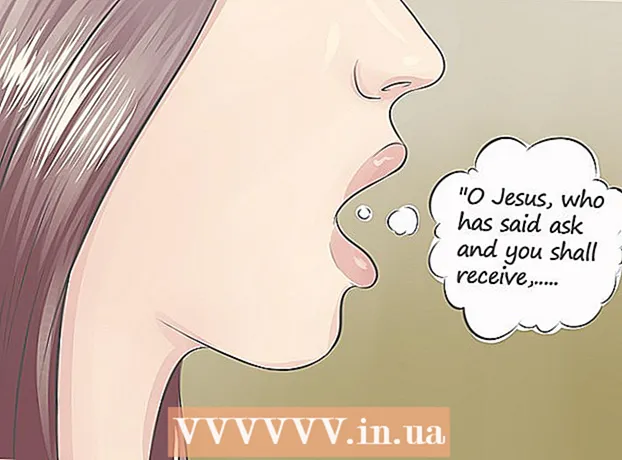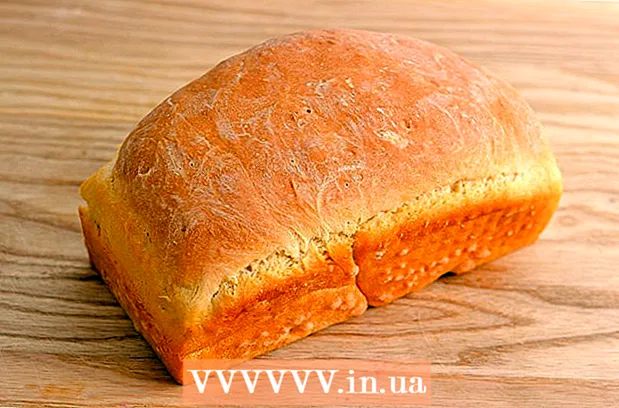
Content
- Steps
- Part 1 of 3: Decide whether to cleanse your horse's foreskin
- Part 2 of 3: Prepare
- Part 3 of 3: Cleaning the foreskin
- What do you need
The foreskin is the skin that protects the horse's penis. Under the foreskin smegma or secretions accumulate, serving as a lubricant. In the wild, horses consume this lubricant naturally during mating, but at home this secretion can accumulate, forming "beans" under the foreskin. This problem does not occur in all horses, so there is no consensus on whether it is necessary to cleanse the foreskin. After consulting your veterinarian, you may decide to periodically cleanse your horse's foreskin as a preventive measure. As a rule, such cleaning should be carried out at least every 6 months for the gelding (castrated horse) and every year for the stallion (non-castrated horse). The horse's genitals are very sensitive, so you need to proceed with caution.
Steps
Part 1 of 3: Decide whether to cleanse your horse's foreskin
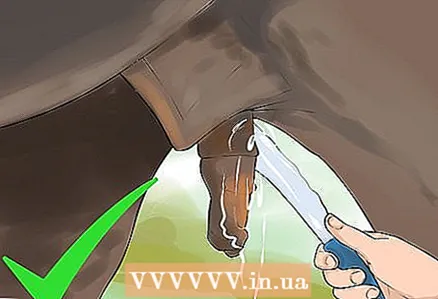 1 Learn about the benefits. In general, the main arguments for washing a horse's foreskin are hygiene and reducing the risk of infection. As a rule, bacterial colonies form around smegma. The nature of the discharge and the likelihood of infections depends on the particular horse. However, excessive accumulation of secretions can lead to irritation and inflammation in any horse. As a result, the foreskin can swell, which can cause the horse to have problems urinating and reproducing. Some owners argue that if too much smegma accumulates, it attracts flies, which are carriers of various diseases.
1 Learn about the benefits. In general, the main arguments for washing a horse's foreskin are hygiene and reducing the risk of infection. As a rule, bacterial colonies form around smegma. The nature of the discharge and the likelihood of infections depends on the particular horse. However, excessive accumulation of secretions can lead to irritation and inflammation in any horse. As a result, the foreskin can swell, which can cause the horse to have problems urinating and reproducing. Some owners argue that if too much smegma accumulates, it attracts flies, which are carriers of various diseases.  2 Learn about the disadvantages. Many experts claim that a horse's foreskin is "self-cleaning," so hand washing is actually harmful. As a result, this can lead to disruption of normal physiological processes in the horse's body or damage to the foreskin. Others argue that it is not necessary to wash the gelding, since as a result of castration, the production of smegma decreases.
2 Learn about the disadvantages. Many experts claim that a horse's foreskin is "self-cleaning," so hand washing is actually harmful. As a result, this can lead to disruption of normal physiological processes in the horse's body or damage to the foreskin. Others argue that it is not necessary to wash the gelding, since as a result of castration, the production of smegma decreases.  3 Check with your veterinarian. In the end, no matter which point of view you agree with, you need to discuss the matter with your veterinarian.When deciding whether to clean the foreskin or not, you need to take into account your specific situation - whether it is your horse that needs it. Some horses produce more smegma and accumulate faster. This may be due to the peculiarities of the hormonal glands or the presence of some problems. Some beans will come naturally and some won't. It is dangerous to do nothing, as they may even require surgery to remove them.
3 Check with your veterinarian. In the end, no matter which point of view you agree with, you need to discuss the matter with your veterinarian.When deciding whether to clean the foreskin or not, you need to take into account your specific situation - whether it is your horse that needs it. Some horses produce more smegma and accumulate faster. This may be due to the peculiarities of the hormonal glands or the presence of some problems. Some beans will come naturally and some won't. It is dangerous to do nothing, as they may even require surgery to remove them.
Part 2 of 3: Prepare
 1 Trim your nails. Cut them as short as possible and / or file sharp edges. Since the foreskin is very sensitive, you should do your best not to scratch your horse. Keep in mind that the horse's instinctive reaction to discomfort in the genitals is to kick and kick. This can lead to serious injury - to you and / or to the horse.
1 Trim your nails. Cut them as short as possible and / or file sharp edges. Since the foreskin is very sensitive, you should do your best not to scratch your horse. Keep in mind that the horse's instinctive reaction to discomfort in the genitals is to kick and kick. This can lead to serious injury - to you and / or to the horse.  2 Wear thin latex gloves. Do not use thick rubber household gloves. This may sound obscene to you, but it is very important to maintain the tactile sensation. You should be able to feel any accumulations of smegma and beans formed from the secretions.
2 Wear thin latex gloves. Do not use thick rubber household gloves. This may sound obscene to you, but it is very important to maintain the tactile sensation. You should be able to feel any accumulations of smegma and beans formed from the secretions.  3 Ask someone to help you hold the horse. The helper can hold the knight by the reins, directing it in the right direction. He can also brush his horse to calm him down while you are doing dirty work. If you do not have an assistant, then tie the horse tightly and securely.
3 Ask someone to help you hold the horse. The helper can hold the knight by the reins, directing it in the right direction. He can also brush his horse to calm him down while you are doing dirty work. If you do not have an assistant, then tie the horse tightly and securely. 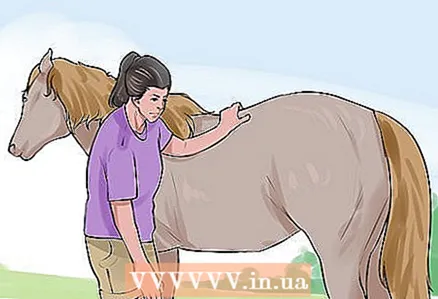 4 With your free hand, gently stroke the horse's back. This will help you feel all the movements of the horse - you can quickly bounce to the side if he moves to kick. Many horse owners and veterinarians claim that if your horse trusts you, a hand can help calm him down.
4 With your free hand, gently stroke the horse's back. This will help you feel all the movements of the horse - you can quickly bounce to the side if he moves to kick. Many horse owners and veterinarians claim that if your horse trusts you, a hand can help calm him down.  5 Stand in front of the horse. It is safest to stand with your shoulder and thigh close to the front legs of the horse. Since horses kick with their hind legs, you need to stay as far away from them as possible.
5 Stand in front of the horse. It is safest to stand with your shoulder and thigh close to the front legs of the horse. Since horses kick with their hind legs, you need to stay as far away from them as possible.  6 Clean where there is sufficient space. Since you will need to use a hose and do not want to be trampled, clean where there is ample space, perhaps in a shed. Do not squeeze into a small stall with your horse. You cannot turn around there.
6 Clean where there is sufficient space. Since you will need to use a hose and do not want to be trampled, clean where there is ample space, perhaps in a shed. Do not squeeze into a small stall with your horse. You cannot turn around there.
Part 3 of 3: Cleaning the foreskin
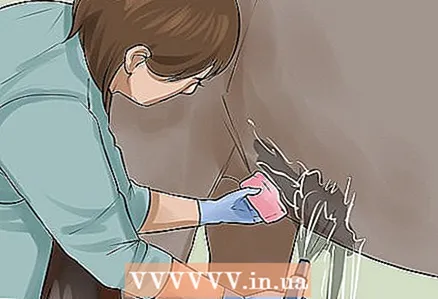 1 Use a soft sponge and hose to gently rinse the foreskin and penis. Start at the belly and work your way up towards the penis so as not to catch the horse by surprise. If possible, use water at room temperature. Hot or cold water can be uncomfortable for the horse. Your task is to wash away dirt and other foreign matter from the outside of the foreskin. When finished, discard the used sponge.
1 Use a soft sponge and hose to gently rinse the foreskin and penis. Start at the belly and work your way up towards the penis so as not to catch the horse by surprise. If possible, use water at room temperature. Hot or cold water can be uncomfortable for the horse. Your task is to wash away dirt and other foreign matter from the outside of the foreskin. When finished, discard the used sponge.  2 Use a lubricant. Lubricate your hands and foreskin with KY Jelly or a special foreskin cleaner. In order to be able to remove smegma or "beans", it is necessary to lubricate this area. In addition, this will make the whole process less stressful / painful for the horse.
2 Use a lubricant. Lubricate your hands and foreskin with KY Jelly or a special foreskin cleaner. In order to be able to remove smegma or "beans", it is necessary to lubricate this area. In addition, this will make the whole process less stressful / painful for the horse. 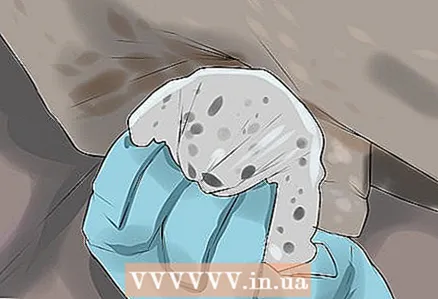 3 Rinse off any dirt from your foreskin. Take a soft sponge or cotton swab and rub gently along the outer edge of the horse's foreskin. Remove any smegma, dirt and other foreign matter that may accumulate there. Wipe and rinse with room temperature water. Don't rub too aggressively. Using a sponge or cotton swab in a circular motion, move along the foreskin.
3 Rinse off any dirt from your foreskin. Take a soft sponge or cotton swab and rub gently along the outer edge of the horse's foreskin. Remove any smegma, dirt and other foreign matter that may accumulate there. Wipe and rinse with room temperature water. Don't rub too aggressively. Using a sponge or cotton swab in a circular motion, move along the foreskin.  4 With one hand, gently push the foreskin back. Move it as far as possible before inserting your hand. In the best case, the foreskin can be pushed back by 2.5-5 cm. This will reduce the pocket that forms around the penis and facilitate cleaning. Not every horse will allow you to do this. If you do this often enough, the horse will get used to the sensation and will not resist.
4 With one hand, gently push the foreskin back. Move it as far as possible before inserting your hand. In the best case, the foreskin can be pushed back by 2.5-5 cm. This will reduce the pocket that forms around the penis and facilitate cleaning. Not every horse will allow you to do this. If you do this often enough, the horse will get used to the sensation and will not resist.  5 With your other hand, remove the smegma around the penis. Most likely, it will be rust colored. This is fine. Smegma (dried discharge) usually flakes and crumbles in the hand.Pull it out as much as possible and then rinse with plenty of warm water.
5 With your other hand, remove the smegma around the penis. Most likely, it will be rust colored. This is fine. Smegma (dried discharge) usually flakes and crumbles in the hand.Pull it out as much as possible and then rinse with plenty of warm water. 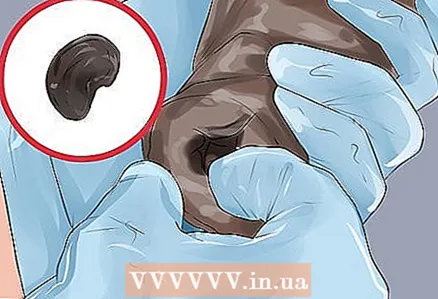 6 Check for beans (smegma chunks) in the urethra. Insert your little finger into your urethra and feel for a hard lump. If there is one, slowly roll it out of the tip of the horse's penis. Some people call it picking the beans. You will feel it before you reach the first joint. The beans rarely form deeper, but if this happens, then surgical intervention will be required to remove them.
6 Check for beans (smegma chunks) in the urethra. Insert your little finger into your urethra and feel for a hard lump. If there is one, slowly roll it out of the tip of the horse's penis. Some people call it picking the beans. You will feel it before you reach the first joint. The beans rarely form deeper, but if this happens, then surgical intervention will be required to remove them. 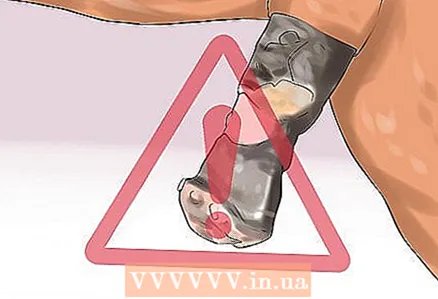 7 Check for any irregularities. Pay attention to the skin for thickening, grayish color in the usually pink areas, any damage. If you notice any of the above, then consult your veterinarian. These disorders can be the result of improper care of the genitals or a symptom of food, bacterial and viral diseases.
7 Check for any irregularities. Pay attention to the skin for thickening, grayish color in the usually pink areas, any damage. If you notice any of the above, then consult your veterinarian. These disorders can be the result of improper care of the genitals or a symptom of food, bacterial and viral diseases. 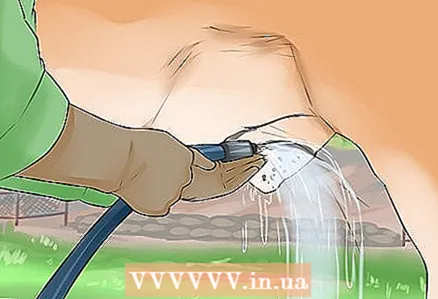 8 Use a sponge or hose to gently rinse your foreskin and penis. If you've used soap, be sure to rinse it off completely. Residual soap can irritate the skin.
8 Use a sponge or hose to gently rinse your foreskin and penis. If you've used soap, be sure to rinse it off completely. Residual soap can irritate the skin. 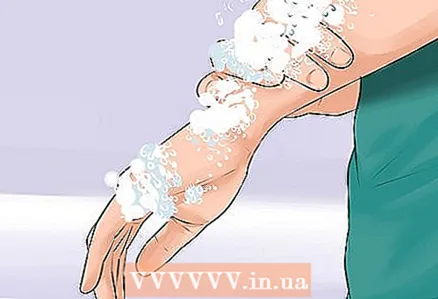 9 Get yourself in order. You've just done your dirty work. Using a strong antibacterial soap, wash your hands and forearms several times.
9 Get yourself in order. You've just done your dirty work. Using a strong antibacterial soap, wash your hands and forearms several times.
What do you need
- Horse
- Latex gloves
- Bucket and soft sponge or hose
- Warm water - body temperature
- Soap for cleaning the foreskin (if necessary). Some ideas: Excalibur (a gel that can be quite cold, so warm it up in your hands before applying), a mild dye and scent free shampoo, or Ivory soap.


